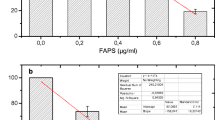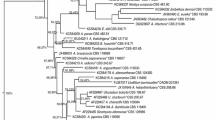Abstract
A study was made of the action of fatty acids onCandida tropicalis growing on hydrocarbon substrates at pH 4.0. It was shown that straight-chain acids are metabolized by the organism as long as their concentration in the aqueous phase remains below a certain level which is designated the “critical concentration”. Below this concentration their only effect is to lengthen the lag phase, while above it, growth is completely suppressed. The critical concentrations of the acids in the aqueous phase diminish logarithmically with increasing chain length. Acids with a higher molecular weight than undecanoic acid do not exist in a critical concentration at pH 4.0, owing to the fact that at this pH their in the aqueous phase is too low.
Unlike straight-chain acids, branched-chain acids reduce the growth rate of the yeast at concentrations below the critical concentration. However, their critical concentrations are always higher than those observed for the straight-chain acid containing the same number of carbon atoms. The critical concentrations rise with the increasing proximity of the branching to the polar group, and with the increasing size of the side-chain.
It was shown that when acids are attacked by this organism, the attack occurs primarily at the acid end of the molecule and very little ω-oxidation occurs. The presence of a methyl, or other group, in the α-position almost completely prevents the metabolism of the acid.
Similar content being viewed by others
References
Ballou, G. A., Boyer, P. D. andLuck, J. M. 1945. The electrophoretic mobility of human serum albumin as affected by lower fatty acid salts. - J. Biol. Chem.159: 111–116.
Boyer, P. D., Lum, F. G., Ballou, G. A., Luck, J. M. andRice, R. G. 1946. The combination of fatty acids and related compounds with serum albumin. I. Stabilization against heat denaturation. - J. Biol. Chem.162: 181–198.
Boyer, P. D. Ballou, G. A. andLuck, J. M. 1947. The combination of fatty acids and related compounds with serum albumin. III. The nature and extent of the combination. - J. Biol. Chem.167: 407–424.
Burrows, S. 1970. Baker's yeast, p. 349–420.In A. H. Rose and J. S. Harrison, [eds.], The Yeasts, Vol. 3. - Academic Press, London and New York.
Foster, J. W. 1962. Hydrocarbons as substrates for microorganisms. - Antonie van Leeuwenhoek28: 241–274.
Hoffman, C., Schweitzer, T. R. andDalby, G. 1939. Fungistatic properties of the fatty acids and possible biochemical significance. - Food Res.4: 539–545.
Hotchkiss, R. D. 1946. The nature of the bacteriocidal action of surface active agents. - Ann. New York Acad. Sci.46: 479–493.
Ingram, M. 1955. An introduction to the biology of yeasts. - Sir Isaac Pitman and Sons, London.
Khan, M. andKatamay, M. 1969. Antagonistic effect of fatty acids againstSalmonella in meat and bone meal. - Appl. Microbiol.17: 402–404.
Kipling, J. J. 1965. Adsorption from solutions of non-electrolytes. - Academic Press, London.
Lampen, J. O. andWeinstock, J. O. 1962. Mechanism of acetic acid toxicity for yeast. - Bacteriol. Proc.1962: 123.
Lowery, C. E. 1967. Hydrocarbons as substrates for molds and yeasts. - Diss. Abstr.28: 461-B.
Maeson, Th. J. M. andLako, E. 1952. The influence of acetate on the fermentation of baker's yeast. - Biochim. Biophys. Acta9: 106–107.
McKenna, E. J. andKallio, R. E. 1965. The biology of hydrocarbons. - Annu. Rev. Microbiol.19: 183–208.
Neal, A. L., Weinstock, J. O. andLampen, J. O. 1965. Mechanisms of fatty acid toxicity for yeast.- J. Bacteriol.90: 126–131.
Nordström, K. 1964. Formation of esters from acids by brewer's yeast. IV. Effect of higher fatty acids and toxicity of lower fatty acids. - J. Inst. Brewing70: 233–242.
Oura, E., Suomalainen, H. undCollander, R. 1959. Die Permeabilität der Hefezellen für Säuren. - Physiol. Plantarum12: 534–544.
Rizvanov, K. andPopov, V. Khr. 1967. The influence of fatty acid salts on the growth of yeasts. - Prikl. Biokhim. Mikrobiol.3: 660–664.
Robb, I. D. 1966. Determination of the aqueous solubility of fatty acids. - Aust. J. Chem.19: 2281–2284.
Samson, F. E., Katz, A. M. andHarris, D. L. 1955. Effects of acetate and other short-chain fatty acids on yeast metabolism. - Arch. Biochem. Biophys.54: 406–423.
Singleton, W. S. 1960. Solution properties, p. 609–678.In K. S. Markley, [ed.], Fatty acids, their chemistry, properties, production and uses. Interscience Publishers, New York.
Suomalainen, H. 1968. The structure and function of the yeast cell, p. 1–31.In A. K. Mills, [ed.], Aspects of yeast metabolism. - Blackwell, Oxford.
Suomalainen, H. 1969. Trends in physiology and biochemistry of yeasts. - Antonie van Leeuwenhoek35: Suppl.: Yeast Symposium 1969, p. 83–111.
Tani, I., Kuriyama, M. andOtsuka, T. 1967. Study of the superficial structure of fungi. II. Alteration of cell permeability and the antibiotic effect of fatty acids onSaccharomyces cerevisiae. - Jap. J. Bacteriol.22: 634–40.
Troshin, A. S. 1966. Problems of cell permeability. First English Edition. Pergamon Press, Oxford. pages 179–180.
Author information
Authors and Affiliations
Additional information
This work was carried out at: Société Française des Pétroles BP, Laboratoires de Microbiologie, Raffinérie de Lavéra, 13-Lavéra, France.
Permission to publish this paper has been given by the British Petroleum Company Limited.
Rights and permissions
About this article
Cite this article
Bell, G.H. The action of monocarboxylic acids onCandida tropicalis growing on hydrocarbon substrates. Antonie van Leeuwenhoek 37, 385–400 (1971). https://doi.org/10.1007/BF02218509
Received:
Issue Date:
DOI: https://doi.org/10.1007/BF02218509




